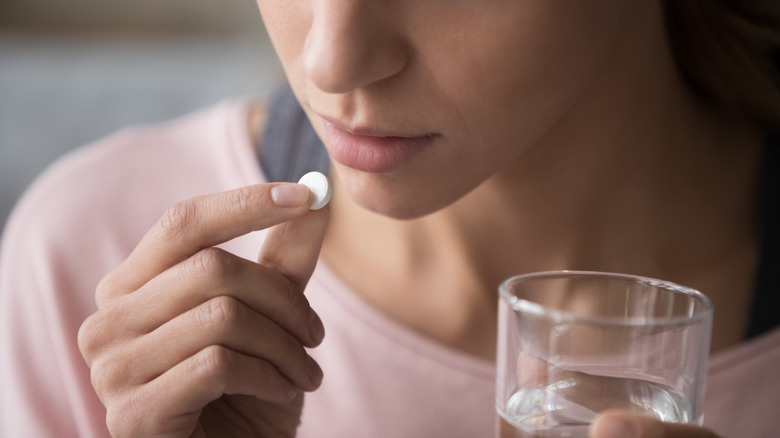A Side Effect Of Antidepressants That Might Surprise You
If you've taken antidepressants, you know it's not always a walk in the park, especially in the beginning when you and your doctor are trying to determine the best fit. Antidepressants have proven helpful and effective for many individuals looking to ease depression and anxiety, despite reported side effects that may occur. According to the journal Psychiatry (Edgmont), 38% percent of patients reported experiencing one or more side effects while taking an antidepressant. Of the side effects reported, patients considered 25% of them to be "very bothersome" or "extremely bothersome." While some side effects can be uncomfortable, like sexual functioning, drowsiness, and weight gain (which head the list as the most common side effects of antidepressants), other side effects are just downright strange. Amitriptyline is a medication used to treat depression that has some people peering into their toilets and scratching their heads. Here's a surprisingly strange thing that can happen when you take amitriptyline.
Amitriptyline and urine color
Amitriptyline can actually cause urine to appear green or blue. Pharmacy Times reports there are many drugs that can cause our urine to change colors without the presence of any serious underlying medical conditions. While the color of urine typically ranges somewhere between pale yellow and dark amber, when amitriptyline is taken, the chemical structure of the drug may be broken down by the body and produce blue pigments in the urine. Urine will appear more green depending on how yellow the urine is. While this can seem very frightening, it's likely not dangerous. Annals of Laboratory Medicine reports that a change in urine color due to medication is unlikely to be harmful. While this symptom is generally uncommon, it's important to discuss any troubling side effects with your doctor, so they can decide if further investigation is needed to rule out other health issues. This particular side effect typically only lasts as long as one is taking the medication, and will clear up quickly after stopping.
Amitriptyline still considered a leading drug
Despite the odd aforementioned side effect, amitriptyline is still a common drug, with leading rates of efficacy for depression as of 2018. Cambridge University Press conducted a systematic review of 186 randomized control trials comparing amitriptyline with other tricyclics/heterocyclics or with an SSRI, and found an overall estimated efficacy significantly favoring amitriptyline. However, dropout rates were higher in the amitriptyline group than the control drug group, leading to the conclusion that amitriptyline is less well tolerated than other classes of antidepressants, but slightly more patients recover than they do on alternative antidepressants. While WebMD lists a total of about 75 possible side effects from taking amitriptyline, most are considered rare. However, the most common symptoms reported include dry mouth, drowsiness, dizziness, weight gain, increased hunger, and headache. Drugs.com also warns that those who have recently had a heart attack should not use amitriptyline. They also report that thoughts of suicide may occur when first starting the drug, especially for those under 24. Regular visits with a medical professional are recommended in the first 12 weeks of treatment in order to monitor symptoms. Lastly, for those experiencing new or worsening symptoms such as mood changes, behavior changes, panic attacks, difficulty sleeping, irritation, agitation, hostility, aggressiveness, or thoughts of suicide or hurting oneself, they should speak with their doctor immediately.



